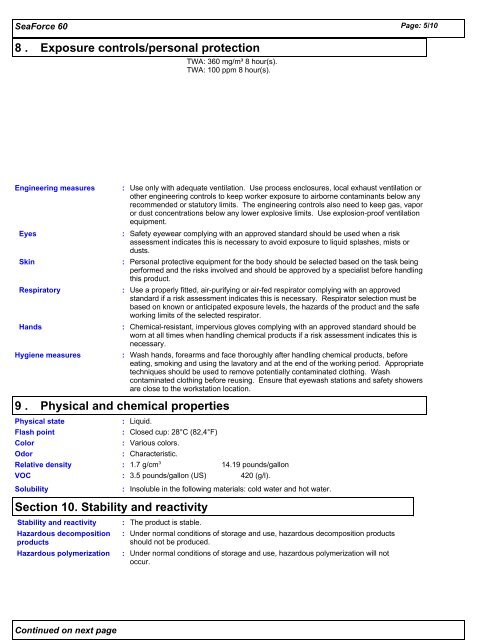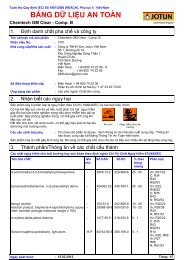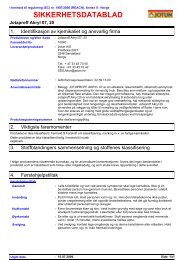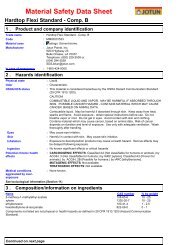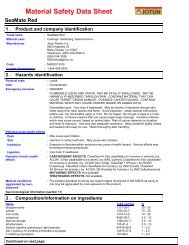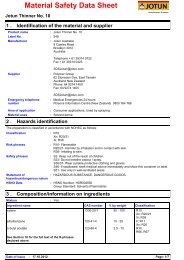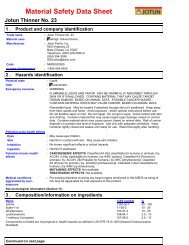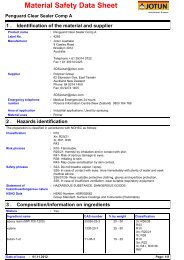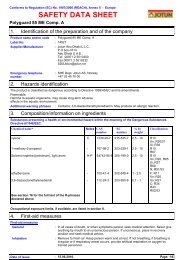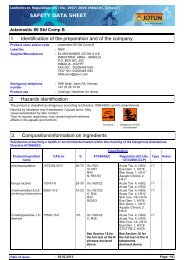SDS - SeaForce 60 - Marine_Protective - English (us) - Jotun
SDS - SeaForce 60 - Marine_Protective - English (us) - Jotun
SDS - SeaForce 60 - Marine_Protective - English (us) - Jotun
You also want an ePaper? Increase the reach of your titles
YUMPU automatically turns print PDFs into web optimized ePapers that Google loves.
<strong>SeaForce</strong> <strong>60</strong> Page: 5/108 .Exposure controls/personal protectionTWA: 3<strong>60</strong> mg/m³ 8 hour(s).TWA: 100 ppm 8 hour(s).Engineering measuresEyesSkinRespiratoryHands :Hygiene measures: Use only with adequate ventilation. Use process enclosures, local exha<strong>us</strong>t ventilation orother engineering controls to keep worker exposure to airborne contaminants below anyrecommended or statutory limits. The engineering controls also need to keep gas, vaporor d<strong>us</strong>t concentrations below any lower explosive limits. Use explosion-proof ventilationequipment.:::Safety eyewear complying with an approved standard should be <strong>us</strong>ed when a riskassessment indicates this is necessary to avoid exposure to liquid splashes, mists ord<strong>us</strong>ts.Personal protective equipment for the body should be selected based on the task beingperformed and the risks involved and should be approved by a specialist before handlingthis product.Use a properly fitted, air-purifying or air-fed respirator complying with an approvedstandard if a risk assessment indicates this is necessary. Respirator selection m<strong>us</strong>t bebased on known or anticipated exposure levels, the hazards of the product and the safeworking limits of the selected respirator.Chemical-resistant, impervio<strong>us</strong> gloves complying with an approved standard should beworn at all times when handling chemical products if a risk assessment indicates this isnecessary.: Wash hands, forearms and face thoroughly after handling chemical products, beforeeating, smoking and <strong>us</strong>ing the lavatory and at the end of the working period. Appropriatetechniques should be <strong>us</strong>ed to remove potentially contaminated clothing. Washcontaminated clothing before re<strong>us</strong>ing. Ensure that eyewash stations and safety showersare close to the workstation location.9 .Physical and chemical propertiesPhysical stateFlash pointColorOdorRelative densityVOC: Liquid.: Closed cup: 28°C (82,4°F): Vario<strong>us</strong> colors.: Characteristic.: 1.7 g/cm 3: 3.5 pounds/gallon (US)14.19 pounds/gallon420 (g/l).Solubility:Insoluble in the following materials: cold water and hot water.Section 10. Stability and reactivityStability and reactivityHazardo<strong>us</strong> decompositionproductsHazardo<strong>us</strong> polymerization:::The product is stable.Under normal conditions of storage and <strong>us</strong>e, hazardo<strong>us</strong> decomposition productsshould not be produced.Under normal conditions of storage and <strong>us</strong>e, hazardo<strong>us</strong> polymerization will notoccur.Continued on next page


